The ASUS ROG Strix X570-E Gaming Motherboard Review
by Gavin Bonshor on January 25, 2021 11:00 AM EST- Posted in
- Motherboards
- AMD
- Asus
- ROG
- AM4
- Ryzen 3000
- X570
- Strix X570-E
- Ryzen 5000
- X570-E Gaming
Gaming Performance
World of Tanks enCore
Albeit different to most of the other commonly played MMO or massively multiplayer online games, World of Tanks is set in the mid-20th century and allows players to take control of a range of military based armored vehicles. World of Tanks (WoT) is developed and published by Wargaming who are based in Belarus, with the game’s soundtrack being primarily composed by Belarusian composer Sergey Khmelevsky. The game offers multiple entry points including a free-to-play element as well as allowing players to pay a fee to open up more features. One of the most interesting things about this tank based MMO is that it achieved eSports status when it debuted at the World Cyber Games back in 2012.
World of Tanks enCore is a demo application for a new and unreleased graphics engine penned by the Wargaming development team. Over time the new core engine will implemented into the full game upgrading the games visuals with key elements such as improved water, flora, shadows, lighting as well as other objects such as buildings. The World of Tanks enCore demo app not only offers up insight into the impending game engine changes, but allows users to check system performance to see if the new engine run optimally on their system.
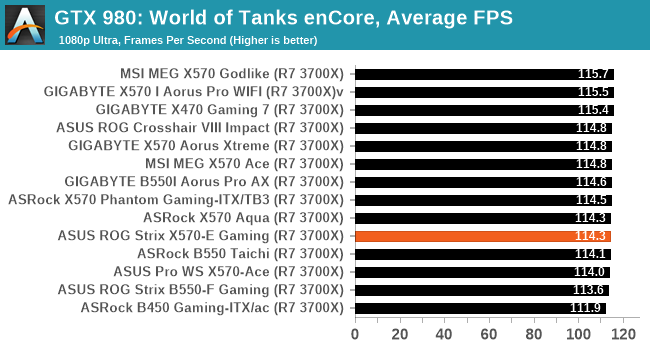
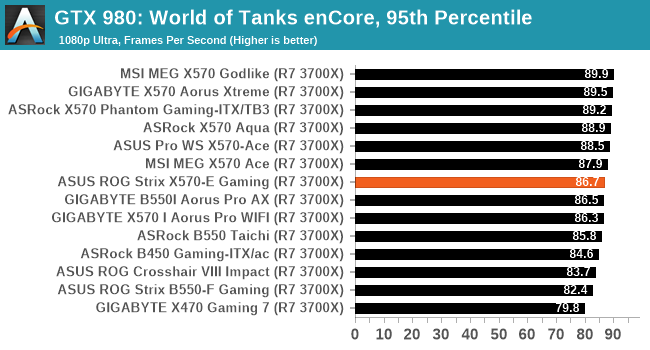
Grand Theft Auto V
The highly anticipated iteration of the Grand Theft Auto franchise hit the shelves on April 14th 2015, with both AMD and NVIDIA in tow to help optimize the title. GTA doesn’t provide graphical presets, but opens up the options to users and extends the boundaries by pushing even the hardest systems to the limit using Rockstar’s Advanced Game Engine under DirectX 11. Whether the user is flying high in the mountains with long draw distances or dealing with assorted trash in the city, when cranked up to maximum it creates stunning visuals but hard work for both the CPU and the GPU.
For our test we have scripted a version of the in-game benchmark. The in-game benchmark consists of five scenarios: four short panning shots with varying lighting and weather effects, and a fifth action sequence that lasts around 90 seconds. We use only the final part of the benchmark, which combines a flight scene in a jet followed by an inner city drive-by through several intersections followed by ramming a tanker that explodes, causing other cars to explode as well. This is a mix of distance rendering followed by a detailed near-rendering action sequence, and the title thankfully spits out frame time data.
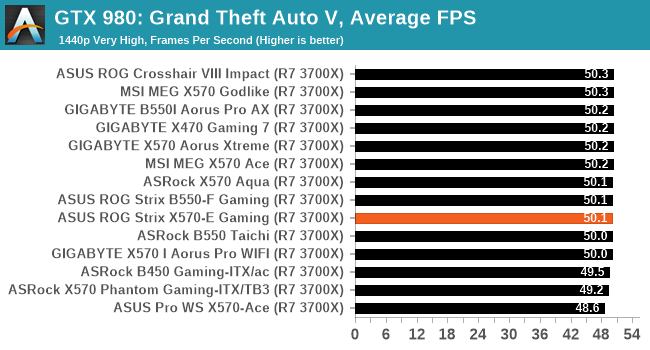
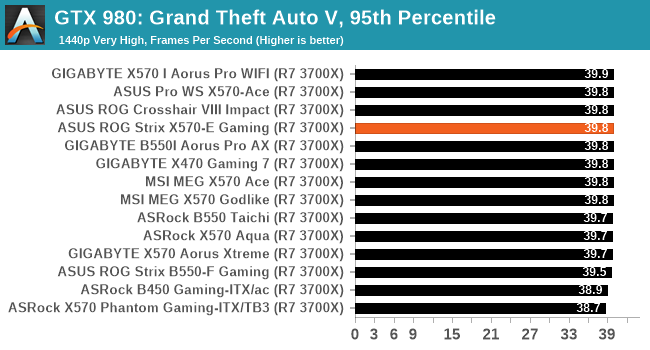
F1 2018
Aside from keeping up-to-date on the Formula One world, F1 2017 added HDR support, which F1 2018 has maintained; otherwise, we should see any newer versions of Codemasters' EGO engine find its way into F1. Graphically demanding in its own right, F1 2018 keeps a useful racing-type graphics workload in our benchmarks.
Aside from keeping up-to-date on the Formula One world, F1 2017 added HDR support, which F1 2018 has maintained. We use the in-game benchmark, set to run on the Montreal track in the wet, driving as Lewis Hamilton from last place on the grid. Data is taken over a one-lap race.
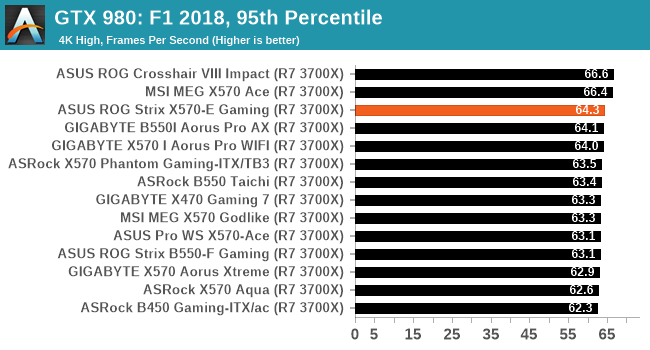
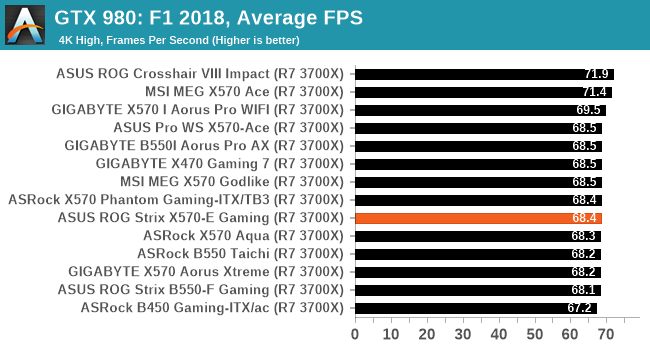


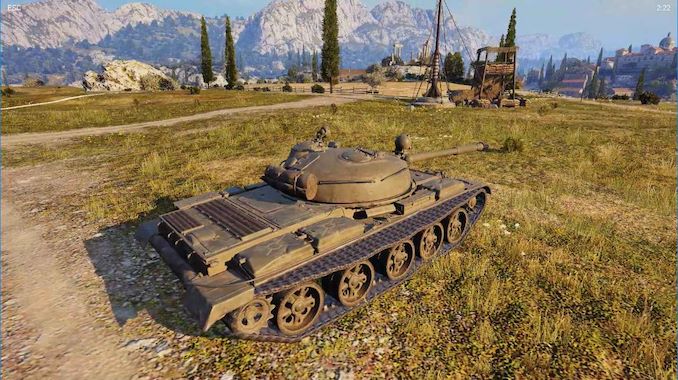










46 Comments
View All Comments
pradeepsekar - Tuesday, January 26, 2021 - link
Correct.Just sharing my experience -
I got a 5950X and Corsair 3600 C18 RAM from the QVL. Loaded up the latest BIOS 2802 and them boom - error and the board would not boot. Had to take it to the ASUS service center, and wait for over an hour. The engineer assigned was super helpful though. He had me wait for some time, and tested the board with a lower processor. He downgraded the BIOS to the next lower stable version, and it worked well when I got it home. Now I am on 3001 and everything continues to work fine. It occasionally greets me with multiple beeps, but ends up booting into Windows anyways... Need to investigate that more but it is not replicable... Anyways, I will stay away from the beta BIOS versions :-)
I agree about the placement of the chipset and the graphics card - they are right next to each other. I am on a NVIDIA Founders edition card. It blows all the warm air out of the chassis and not into it. So for the moment I have not seen high temperatures (yet). The chipset fan looks like a tiny fragile thing one would see on a laptop - with a lot of potential to make a noise when it gets running at a high speed...
Coming from a much older version the menus took some getting used to. All options are present and laid out neatly, as I realized later - with several options that I do not understand fully, and hence do not intend touching till I know better! Just got the RAM running with the XMP (DOCP) profile. I do not intend to overclock the processor - a crazy thought perhaps, but my rig is already screaming fast at everything I throw at it...
Spunjji - Tuesday, January 26, 2021 - link
Beaver M. could learn a lot about what a persuasive, measured post looks like from this one. Cheers for sharing your experience.Knightworld - Wednesday, January 27, 2021 - link
Try running 3200 MHz for the RAM XMP profile. That's what the highest the CPU can handle while being stable without OC. That's the recommended by AMDKnightworld - Wednesday, January 27, 2021 - link
Well of coarse there will be BIOS updates. This is quite an old board in terms of computer standards. Lots of chipset optimisations to accommodate Zen 3 ryzen.Knightworld - Wednesday, January 27, 2021 - link
Also the chipset placement is pretty standard in all boards. Be it ASUS and MSI or Gigabyte or any other MoBo manufacturer. The chipset doesn't ramp up in boost or anything so it usually remains at a constant temp. And using the second slot for main GPU cause more strain on the chipset, since the second slot connects to the chipset and not the CPU. Also with the new GPU from Nvidia, the 3000 series your chipset shouldn't have any issues with the cooling since the special GPU coolers help with that. Tho that is only if you upgrade the GPU.Oxford Guy - Monday, January 25, 2021 - link
'Both the CPU and SoC are Teamed together, which allows the power delivery to run cooler and it improves transient response with quicker bursts of power without the drawbacks of phase doublers.'What drawbacks?
Oxford Guy - Monday, January 25, 2021 - link
'This is also typically run at JEDEC subtimings where possible. It is noted that some users are not keen on this policy, stating that sometimes the maximum supported frequency is quite low, or faster memory is available at a similar price, or that the JEDEC speeds can be prohibitive for performance. While these comments make sense, ultimately very few users apply memory profiles (either XMP or other) as they require interaction with the BIOS. Most users will fall back on JEDEC supported speeds'1. Reviews expensive enthusiast board, where we literally are told about what specific VRM components are present.
2. Makes claims above.
3. Facepalm.
nils_ - Monday, January 25, 2021 - link
I saw this in another benchmark article as well. Know your audience Anandtech, of course we care about this. Most people don't build their own computers, so why even benchmark individual components?Spunjji - Tuesday, January 26, 2021 - link
I'd go as far as to say this is the first instance where I've seen this particular criticism being levelled and haven't been inclined to immediately dismiss it. That text doesn't really belong in this article.Oxford Guy - Monday, January 25, 2021 - link
1. Most users aren't going to use POV-Ray so don't include it in the article.2. Most users aren't going to worry about what VRM components are on the board so don't include it in the article.
3. Most users aren't going to use a RAID array so don't include information about RAID in the article.
4. Most users aren't going to use ethernet that's any faster than gigabit so don't including info about that in the article.
How long should this post be? It's the exact non-credible argument used to test at JEDEC. Now that AMD is rating, officially, for 3200 (which means even the lowest-quality AM4 board will support it), the problem isn't as severe as it was but it's still stupid since everyone has known that 3600 was the sweet spot for the previous round of Zen, not 3200.